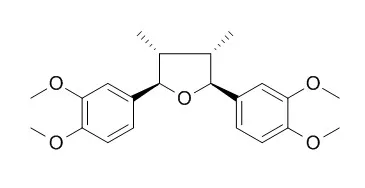| Description: |
Galgravin has anti-inflammatory, and neuroprotective effects, it can promote neuronal survival and neurite outgrowth, protect hippocampal neurons against amyloid beta peptide (Abeta25-35)-induced cytotoxicity, and protect against neuronal death from 1-methyl-4-phenylpyridinium ion (MPP+)-induced toxicity in cultured rat hippocampal neurons. Galgravin has cytotoxic activity against human leukemia (HL-60) tumor cells with the IC50 value of 16.5 ± 0.8 ug/mL. Galgravin also can inhibit bone resorption and may offer a novel compounds for the development of drugs to treat bone-destructive diseases such as osteoporosis.
|
| Targets: |
PARP | p38MAPK | Beta Amyloid | PAFR | Immunology & Inflammation related |
| In vitro: |
| Molecules. 2015 Jul 15;20(7):12757-68. | | Neolignans from Nectandra megapotamica (Lauraceae) Display in vitro Cytotoxic Activity and Induce Apoptosis in Leukemia Cells.[Pubmed: 26184150 ] | Nectandra megapotamica (Spreng.) Mez. (Lauraceae) is a well-known Brazilian medicinal plant that has been used in folk medicine to treat several diseases.
In continuation of our ongoing efforts to discover new bioactive natural products from the Brazilian flora, this study describes the identification of cytotoxic compounds from the MeOH extract of N. megapotamica (Lauraceae) leaves using bioactivity-guided fractionation.
METHODS AND RESULTS:
This approach resulted in the isolation and characterization of eight tetrahydrofuran neolignans: calopeptin (1), machilin-G (2), machilin-I (3), aristolignin (4), nectandrin A (5), veraguensin (6), ganschisandrin (7), and Galgravin (8). Different assays were conducted to evaluate their cytotoxic activities and to determine the possible mechanism(s) related to the activity displayed against human leukemia cells. The most active compounds 4, 5 and 8 gave IC50 values of 14.2 ± 0.7, 16.9 ± 0.8 and 16.5 ± 0.8 μg/mL, respectively, against human leukemia (HL-60) tumor cells. Moreover, these compounds induced specific apoptotic hallmarks, such as plasma membrane bleb formation, nuclear DNA condensation, specific chromatin fragmentation, phosphatidyl-serine exposure on the external leaflet of the plasma membrane, cleavage of PARP as well as mitochondrial damage, which as a whole could be related to the intrinsic apoptotic pathway. |
|
| In vivo: |
| J Pharm Pharmacol. 2004 Sep;56(9):1179-84. | | Evaluation of analgesic and anti-inflammatory activities of Nectandra megapotamica (Lauraceae) in mice and rats.[Pubmed: 15324487 ] |
METHODS AND RESULTS:
The bioactivity-guided phytochemical investigation of the crude hydralcoholic extract of Nectandra megapotamica was carried out using the abdominal constriction test in mice, which led to the isolation of three active compounds: alpha-asarone (1), Galgravin (2) and veraguensin (3). The crude extract (EBCA, 300 mg kg(-1)) and isolated compounds 1,2, and 3, at different doses, were evaluated using the acetic acid-induced abdominal constriction test in mice, carrageenan-induced paw oedema in rats, and hot plate tests in rats. The EBCA showed a significant effect in the abdominal constriction and hot plate tests, but did not show activity in the rat paw oedema assay.
CONCLUSIONS:
All isolated compounds displayed activity in the abdominal constriction test, but only compound 1 was active in the hot plate test. Compounds 2 and 3 displayed activity in the anti-inflammatory assay. It was suggested that the analgesic effects obtained for EBCA could be due mainly to the presence of its major compound, alpha-asarone (1). |
|






 Cell. 2018 Jan 11;172(1-2):249-261.e12. doi: 10.1016/j.cell.2017.12.019.IF=36.216(2019)
Cell. 2018 Jan 11;172(1-2):249-261.e12. doi: 10.1016/j.cell.2017.12.019.IF=36.216(2019) Cell Metab. 2020 Mar 3;31(3):534-548.e5. doi: 10.1016/j.cmet.2020.01.002.IF=22.415(2019)
Cell Metab. 2020 Mar 3;31(3):534-548.e5. doi: 10.1016/j.cmet.2020.01.002.IF=22.415(2019) Mol Cell. 2017 Nov 16;68(4):673-685.e6. doi: 10.1016/j.molcel.2017.10.022.IF=14.548(2019)
Mol Cell. 2017 Nov 16;68(4):673-685.e6. doi: 10.1016/j.molcel.2017.10.022.IF=14.548(2019)